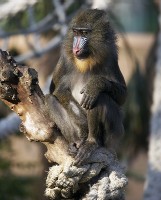Primate Facts
Animal Trivia There are over 300 species of primates in the world”and humans make up one of them.
There are over 300 species of primates in the world”and humans make up one of them.
The pygmy mouse lemur, the smallest primate, can fit in the palm of your hand.
Gorillas are the largest primates and can grow to be over 400 pounds.
Humans and gorillas are so closely related, they can even catch diseases from each other”thus glass enclosures at zoos to prevent disease transmission.
Baby gorillas get the same vaccinations as human babies.
Gorillas build nests at night to sleep with other family members.
Orangutans are the largest tree-dwelling animal.
Orangutans have throat pouches to make their voices heard through the wilderness.
Pygmy marmosets are only 6 inches long as adults and eat the sap from certain trees. They lick out the sap after digging a groove in the bark of the tree.
A howler monkey’s call can travel for three miles! They use their calls to locate other howler monkeys in the area.
Chimpanzees have a variable diet of plants, seeds, fruit, leaves, buds, nuts, shoots, bark, insects, and even honey and fish.
Apes and Chimps can use œtools much like humans”like using stones for hammers to open nuts.
The tip of a spider monkey’s tale can support the weight of its whole body.
Some monkeys are trained to help humans with disabilities. They can assist in reaching for items, turning out lights, getting a drink of water, and even inserting a video cassette or CD into a player.
Gelada baboons live in groups of up to 600 members.
Aye-ayes, which live in Madagascar, use their middle finger to tap on wood to locate the hollow spaces where insects hide. After finding the insects, they then extract them and eat them.
